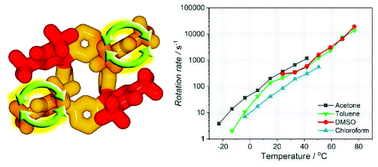Molecular rotor based on an oxidized resorcinarene†
Abstract
Molecular rotors are an important class of dynamic molecules which have been studied not only for their possible uses as components of molecular machines but also because of potential applications as probes of local viscosity in biological media, especially self-assembled membranes. For the former, factors affecting rotational motility are critical while for the latter the rotor activity must be complexed with an output signal (often fluorescence) for reporting of local conditions. Molecular single stator-double rotor activity of an oxidized resorcinarene (fuchsonarene) macrocycle containing unsaturated hemiquinonoid groups at its meso positions was investigated. Fuchsonarenes contain two hemiquinonoid substituents at diagonally-opposed meso-positions with two electron rich phenol groups at the remaining meso-positions between the hemiquinonoid groups. All meso-substituents are in proximity at one side of the resorcinarene macrocycle (so-called rccc-type isomer) with rotational activity of the phenol meso-substituents. Rotation rates of the phenol moieties can be controlled by varying temperature, solvent polarity and acidity of the medium of study with rotation being thermally activated in neutral and acidic media and tunable in the range from 2 s−1 to 20 000 s−1. Experimental and computational data indicate that rotation of the mobile phenol meso-substituents is remotely affected by interactions with acidic solvents at the carbonyl C![[double bond, length as m-dash]](https://www.rsc.org/images/entities/char_e001.gif) O groups of macrocyclic acetyloxy groups, which occurs with the emergence of a lower energy electronic absorption band whose intensity is correlated with both the acidity of the medium and the rotation rate of the phenol substituents. Time-dependent DFT calculations suggest that the low energy band is due to a molecular conformational adjustment affecting electronic conjugation caused by strong interaction of macrocyclic acetyloxy carbonyl groups with the acid medium. The work presents a molecular mechanical model for estimating solution acidity and also gives insight into a possible method for modulating rotor activity in molecular machines.
O groups of macrocyclic acetyloxy groups, which occurs with the emergence of a lower energy electronic absorption band whose intensity is correlated with both the acidity of the medium and the rotation rate of the phenol substituents. Time-dependent DFT calculations suggest that the low energy band is due to a molecular conformational adjustment affecting electronic conjugation caused by strong interaction of macrocyclic acetyloxy carbonyl groups with the acid medium. The work presents a molecular mechanical model for estimating solution acidity and also gives insight into a possible method for modulating rotor activity in molecular machines.



 Please wait while we load your content...
Please wait while we load your content...